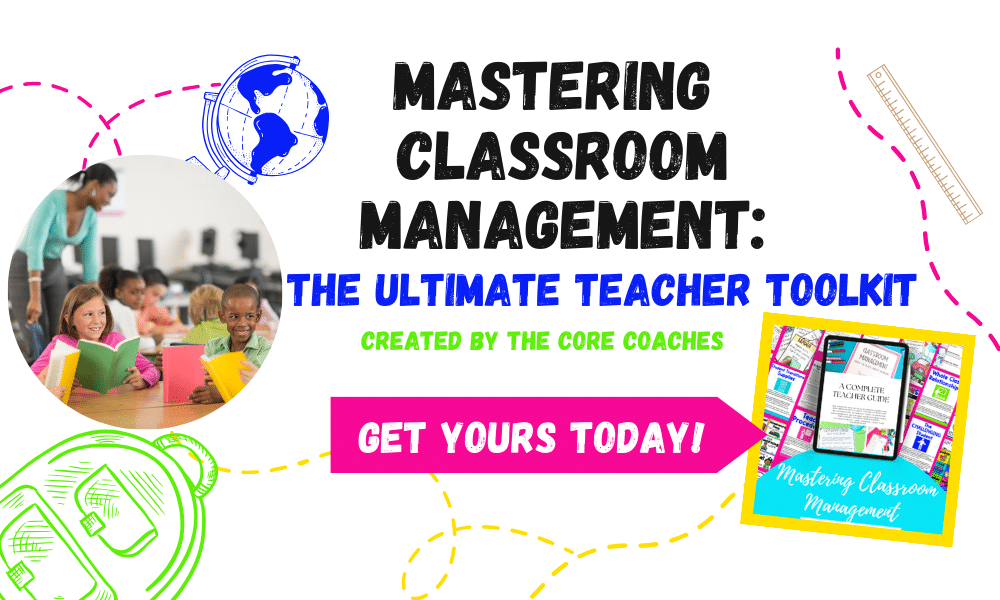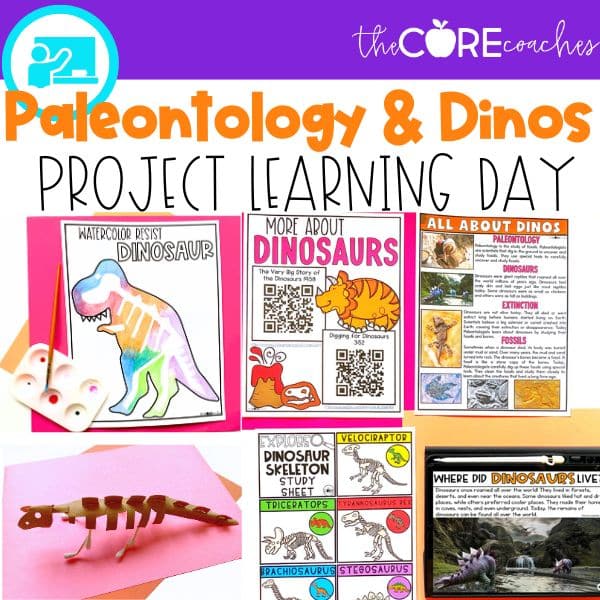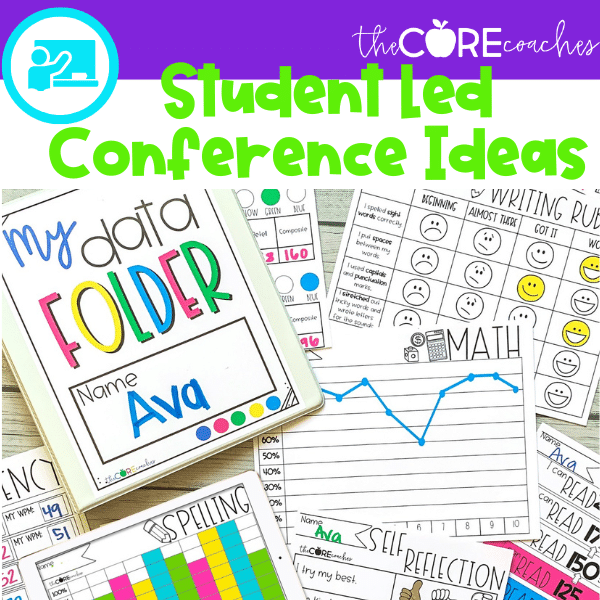Our mission as The Core Coaches has always been to support elementary school teachers in their mission to create thriving classrooms. This includes providing you as a teacher with high-quality teaching materials as well as sharing insight into important teaching practices.
One of the most important practices in a classroom, maybe even THE most important practice, is building a positive classroom community. Why? Because the community you build in your classroom is the heart of each of your student’s learning experiences.
To begin, join us as we explore why community building in the classroom is an essential part of education and various strategies and resources that will empower you to continue building your classroom community
What is a Classroom Community?
The classroom community is the heartbeat of a successful learning environment. It encompasses the relationships, interactions, and shared experiences among students. It also includes the relationship between the teacher and students.
There are several ways to define what a classroom community looks and sounds like. Here are some of the things we looked for in our classrooms and the classrooms we supported as coaches.
An effective classroom community is seen in the relationships between peers and other members of the classroom. This can be seen in thoughtful gestures of kindness and in the genuine interest classmates take in each other’s lives. This includes celebrating their differences and diverse interests.
In addition, the classroom community not only shows positive social interactions but also positivity and progress in learning. Therefore, you may say a thriving classroom community is characterized by the buzz of enthusiastic discussions, where students feel comfortable expressing their opinions and asking questions.
It’s the sound of collaborative group work, where different points of view come together to solve problems and create solutions. It’s a space where differences are celebrated, and inclusivity is embraced, creating an environment where everyone’s unique voice adds to the learning journey.
Further, a focus on building a classroom community helps to foster a sense of belonging, empathy, and collaboration that not only enhances students’ social and emotional development but also lays a strong foundation for academic success.
Why is Classroom Community Important?
As we shared what you may see or hear when building a classroom community you have probably already started to see why a classroom community is important. Let’s explore that further!
Beyond the curriculum, fostering a sense of belonging and camaraderie among students creates an environment where every child feels valued and supported. This environment encourages risk-taking, active participation, and a willingness to explore new concepts without fear of judgment.
Building this type of safe environment allows students to collaborate, share ideas, and celebrate each other’s successes. These are all essential pieces of learning because they give kids opportunities to teach one another and to learn from their peers. Two things that have been proven in research to be some of the most effective ways to learn!
In addition, this type of learning environment helps young learners to vital social skills that extend far beyond the classroom walls. Therefore, creating opportunities for students to learn on their own in the real world.
As you can see, cultivating a positive classroom community not only enriches the educational experience but also equips students with the social and emotional tools they need to thrive in an ever-evolving world.
How to Build a Classroom Community
So, how do you build a classroom community in an elementary school?
Building a strong classroom community involves an approach that focuses on a variety of intentional strategies that can be used as everyday routines.
Here are 8 ideas of effective ways to start building a cooperative and supportive learning environment:
1. Morning Meetings: Start the day with a morning meeting where students gather to share thoughts, feelings, and insights. This sets a positive tone and encourages open communication right from the beginning.
- Classroom Norms: Establish a set of classroom norms or rules that promote respect, active listening, and empathy. This gives students a sense of ownership and responsibility for maintaining a harmonious atmosphere.
- Collaborative Activities: Incorporate group projects and activities so students work together towards a common goal. This fosters teamwork, cooperation, and the opportunity for students to learn from one another.
- Community-Building Games: Interactive games encourage students to learn more about their classmates. Icebreakers and team-building games forge connections and create a sense of unity.
- Student Centered Classroom: To give students even more ownership of their learning, give them ownership of the learning space by involving them in decorating the classroom. This includes showcasing their work and having them help make bulletin boards and anchor charts.
- Class Meetings: Hold regular class meetings where students can discuss important topics, share their thoughts, and participate in decision-making. This fosters a sense of agency and teaches democratic values.
- Social and Emotional Learning: Add activities in the classroom to explore social and emotional needs. This helps students be more aware of their feelings, as well as the feelings of others, which creates a more aware learning environment.
- Inclusive Curriculum: Include diverse perspectives and cultural references into your curriculum. This validates students’ identities and fosters an inclusive environment where everyone feels represented
Bonus: 2 more ways to build a supportive learning environment
- Kindness Initiatives: Initiate projects centered around acts of kindness, such as compliment circles or random acts of kindness challenges. These activities reinforce positive behavior and empathy.
- Classroom Routines: Establish classroom routines so students know what to expect during certain lessons. A good example is a reading routine where students know where to sit on the carpet, how to move from their desks, and how to quickly and quietly return to their desks.
Traits of a Classroom Community
To summarize, by weaving these strategies into your teaching approach, you’ll create a classroom community where students feel valued, connected, and motivated to engage in both personal and collective growth.
And to make building a classroom community even easier, we have created several teaching resources to support you in the process.
Scroll to take a look at a variety of activities.
Classroom Community Building Activities
Morning Meeting
As mentioned above, implementing Morning Meeting in your classroom is one of the most effective ways to build your classroom community. If you have never held morning meetings, this resource has everything you need to start on the first day of school.
Attention Getters
Attention getters are an excellent way to develop an easy routine in the classroom. They give all students a clear expectation and help manage transitions in the classroom. This maintains an overall positive classroom environment that supports the goals of the community.
Grouping Cards
Grouping cardsmake it easy for you as the teacher to quickly move students into groups or pairs. Moreover, they help to diversify groups throughout the year so that students are not always working with the same partners and can get to know everyone in class.
Mindful Movement
There are many different ways to teach students about their social and emotional wellbeing. Mindful movement is one way that makes it approachable and fun! It is also the perfect brain break!
Mindful Yoga
In addition to the fun poses we share in our mindfulness movement resource, we also have a more traditional mindful yoga resource. This helps students become aware of their body and breathing through yoga poses that are accessible for young kids.
Mindful Breathing
For the days that you may not want to get kids out of their seats, give mindful breathing a try! Our mindful breathing exercises are the perfect way to help students refocus and tune into their minds and bodies – all while staying seated.
Affirmations
It is a different world and our students, even as young as PreK, are often faced with the overwhelming emotions of stress, anxiety, and depression. In addition to the mindfulness practices above affirmations are another excellent practice to use to manage these difficult emotions.
Behavior Buddies
Behavior is an integral part of building a positive classroom environment. Specially, fostering kind and positive behavior among all students. These behavior buddies are one way to teach students different behaviors and expectations.
Beyond just teaching students the expected behaviors these provide you with a clear tool to reference all year long. For example, “…are we being respectful like rooster?”
Back to School Teacher Favorites
While you can build a classroom community any time of the year it is always easiest to do it at the beginning of a new school year. Therefore, we created a Back to School bundle with some of our favorite resources to use in creating a new community for the year.
In addition to this bundle, we also have our favorite Activities for September bundled up to support you with several core focused activities that are ready to teach because as we said in the beginning of this post, our goal is to support YOU!
-
Sale!
Mastering Classroom Management: Ultimate Teacher Toolkit
$49.99Original price was: $49.99.$39.99Current price is: $39.99. Add to cart -
Transition Songs for Back to School Classroom Management
$6.00 Add to cart -
Student Grouping Cards – Partner Pairing Cards Bundle – for groups of 2 or more
$6.00 Add to cart -
Morning Meeting Slides – Morning Meeting Greeting, Activity, & Sharing Cards
$10.00 Add to cart -
Morning Greeting Choices
$4.00 Add to cart -
Editable Student Data Folder
$6.00 Add to cart






